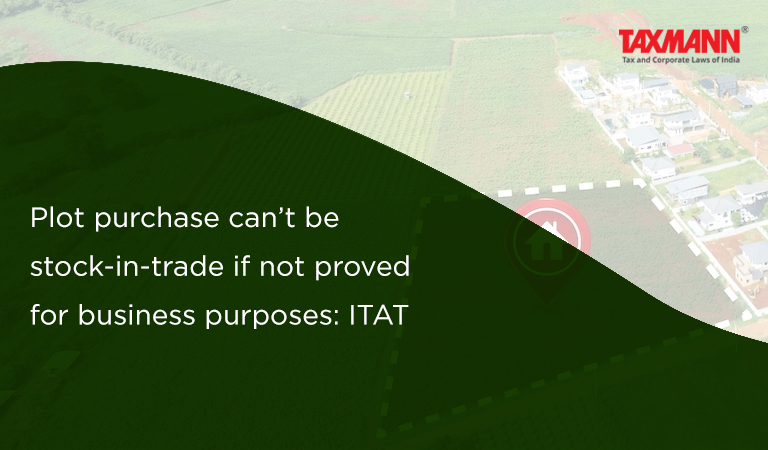Plot purchase can’t be stock-in-trade if not proved for business purposes: ITAT
- Blog|News|Income Tax|
- 2 Min Read
- By Taxmann
- |
- Last Updated on 16 February, 2023

Case Details: Ranjit Shivram Raut v. Income-tax officer - [2023] 146 taxmann.com 474 (Mumbai-Trib.)
Judiciary and Counsel Details
-
- Amit Shukla, Judicial Member & Om Prakash Kant, Accountant Member
- Subodh Ratnaparkhi, AR for the Appellant.
- Smt. Mahita Nair & T. Shankar, CIT DRs for the Respondent.
Facts of the Case
Assessee-individual was engaged in the business of undertaking small civil construction work. During the relevant assessment year, the assessee purchased three plots of land at a very less value and filed its return of income declaring income from salary and house property.
During the scrutiny proceedings, the Assessing Officer (AO) noticed that the assessee has purchased three plots at a significantly lesser value than their market value and issued statutory notice. In response, the assessee contended that the plots are purchased for subsequent resale ie., in the nature of stock-in-trade and not a capital asset. Dissatisfied by the response, AO made additions to the income as per section 56(2)(vii)(b) and computed the tax liability accordingly.
On appeal, CIT(A) upheld the additions made by AO. Aggrieved-assessee preferred an appeal to the Mumbai Tribunal.
ITAT Held
The Tribunal held that the classification of any transaction to be treated as a capital asset or stock in trade depends upon multiple factors including the intention of holding, frequency of transactions, the volume of transactions, treatment in books of account, etc. Assessee contended that the plots were treated as stock but he was never engaged in the trading of plots of land. This transaction is an isolated transaction of purchase and cannot be considered a frequent transaction of trade.
The explanatory notes issued by CBDT by way of Circular No. 01/2011 that section 56(2)(vii)(b) is applicable only when the property is held as a capital asset in the hands of the recipient.
In the instant case, the assessee failed to demonstrate the fact as to how he treats such plots as stock-in-trade of his business. The mere presumption that the plots are intended for further sale cannot be considered a sufficient and appropriate reason to treat them as stock-in-trade.
Therefore, the Tribunal upheld the order of CIT(A) and taxed the income under section 56(2)(vii)(b).
List of Cases Reviewed
-
- CIT v. Associated Industrial Development Co. (P.) Ltd. [1971] 82 ITR 586 (SC) (para 4.4) followed.
List of Cases Referred to
-
- CIT v. Associated Industrial Development Co. (P.) Ltd. [1971] 82 ITR 586 (SC) (para 4.4).
Disclaimer: The content/information published on the website is only for general information of the user and shall not be construed as legal advice. While the Taxmann has exercised reasonable efforts to ensure the veracity of information/content published, Taxmann shall be under no liability in any manner whatsoever for incorrect information, if any.

Taxmann Publications has a dedicated in-house Research & Editorial Team. This team consists of a team of Chartered Accountants, Company Secretaries, and Lawyers. This team works under the guidance and supervision of editor-in-chief Mr Rakesh Bhargava.
The Research and Editorial Team is responsible for developing reliable and accurate content for the readers. The team follows the six-sigma approach to achieve the benchmark of zero error in its publications and research platforms. The team ensures that the following publication guidelines are thoroughly followed while developing the content:
- The statutory material is obtained only from the authorized and reliable sources
- All the latest developments in the judicial and legislative fields are covered
- Prepare the analytical write-ups on current, controversial, and important issues to help the readers to understand the concept and its implications
- Every content published by Taxmann is complete, accurate and lucid
- All evidence-based statements are supported with proper reference to Section, Circular No., Notification No. or citations
- The golden rules of grammar, style and consistency are thoroughly followed
- Font and size that’s easy to read and remain consistent across all imprint and digital publications are applied




